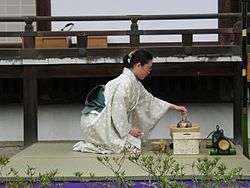History of tea in Japan
The history of tea in Japan has its earliest known references in a text written by a Buddhist monk in the 9th century. Tea became a drink of the religious classes in Japan when Japanese priests and envoys sent to China to learn about its culture brought tea to Japan. The first form of tea brought from China was probably brick tea (磚茶 tancha). Ancient recordings indicate the first batch of tea seeds were brought by a priest named Saicho in 805 and then by another named Kukai in 806. It became a drink of the royal classes when Emperor Saga, the Japanese emperor, encouraged the growth of tea plants. Seeds were imported from China, and cultivation in Japan began.
Kissa Yōjōki
In 1191, the famous Zen priest Eisai (1141–1215) brought back tea seeds to Kyoto. Some of the seeds given to the priest Myoe Shonin became the basis for Uji tea. The oldest tea specialty book in Japan, Kissa Yōjōki (喫茶養生記 "How to Stay Healthy by Drinking Tea") was written by Eisai. The two-volume book was written in 1211 after his second and last visit to China. The first sentence states, "Tea is the ultimate mental and medical remedy and has the ability to make one's life more full and complete". The preface describes how drinking tea can have a positive effect on the five vital organs, especially the heart. It discusses tea's medicinal qualities, which include easing the effects of alcohol, acting as a stimulant, curing blotchiness, quenching thirst, eliminating indigestion, curing beriberi disease, preventing fatigue, and improving urinary and brain function. Part One also explains the shapes of tea plants, tea flowers and tea leaves and covers how to grow tea plants and process tea leaves. Part Two discusses the specific dosage and method required for individual physical ailments.
Eisai was also instrumental in introducing tea consumption to the warrior class, which rose to political prominence after the Heian Period. Eisai learned that Shogun Minamoto-no-Sanetomo had a habit of drinking too much every night. In 1214, Eisai presented a book he had written to the general, lauding the health benefits of tea drinking. After that, the custom of tea drinking became popular among the warrior (samurai class).
Soon, green tea became a staple among cultured people in Japan—a brew for the gentry and the Buddhist priesthood, alike. Production grew and tea became increasingly accessible, though still a privilege enjoyed mostly by the upper classes.
Roasting process introduced to Japan
In the 14th century Ming Dynasty, southern China and Japan enjoyed much cultural exchange. Significant merchandise was traded and the roasting method of processing tea became common in Kyushu, Japan. Since the steaming (9th century) and the roasting (13th century) methods were brought to Japan during two different periods, these teas are completely distinct from each other.
Japan tea culture emerges
The pastimes made popular in China in the 12th and 13th centuries – reading poetry, writing calligraphy, painting, and discussing philosophy while enjoying tea – eventually became popular in Japan and with samurai society. The modern tea ceremony developed over several centuries. The historical figure considered most influential in its development was Sen Rikyū (1522–1591). In fact, both the beverage and the ceremony surrounding it played a prominent role in feudal diplomacy. Many of the most important negotiations among feudal clan leaders were carried out in the austere and serene setting of the tea ceremony. By the end of the 16th century, the current "Way of Tea" was established. Eventually, green tea became available to the masses, making it the nation's most popular beverage.
Modern Japanese green tea
In 1740, Soen Nagatani developed Japanese sencha (Japanese: 煎茶), which is an unfermented form of green tea. To prepare sencha, tea leaves are first steam-pressed, then rolled and dried into a loose tea. The dried leaves are brewed with hot water to yield the final drink. Sencha is now one of Japan's mainstay teas.
Rolling machines
At the end of the Meiji era (1868–1912), machine manufacturing of green tea was introduced and began replacing handmade tea. Machines took over the processes of primary drying, tea rolling, secondary drying, final rolling, and steaming.
Automation
Automation contributed to improved quality and reduced labour. Sensor and computer controls were introduced to machine automation so unskilled workers can produce superior tea without compromising quality. Certain regions in Japan are known for special types of green tea, as well as for teas of exceptional quality, making the leaves themselves a highly valued commodity. Uji is still famous for its tea. Today, roasted green tea is not as common in Japan and powdered tea is used in ceremonial fashion.

